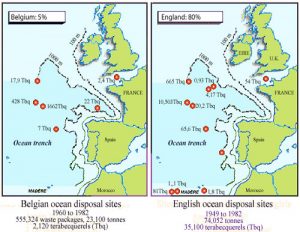From ocean dumping to the first final repository

Ocean dumping location maps Between 1949 and 1966, the United Kingdom, and to a lesser extent Belgium and Switzerland, regularly dumped waste at various sites in the Atlantic Ocean and English Channel. Most of these dump sites are located at depths of more than 1000 m. The UK and Belgium also dumped some waste in the Casquets trench, around 15 km northwest of Cap de La Hague.
ANDRA
The issue of the fate of radioactive waste began to emerge in the United States, the Soviet Union and the United Kingdom during the nuclear arms race that followed the second world war. Radioactive waste volumes were still very small and the problem appeared minor compared to the strategic issues at stake.
In France, it was the Atomic Energy Commission (Commissariat à l’Energie Atomique – CEA) that raised awareness of the problem of managing waste relating to the acquisition of nuclear weapons in the late 1950’s and later, the launch of the civilian nuclear power industry marked by the startup of the first graphite-gas reactors.
During this early period, the scientific community considered that dumping radioactive waste on the ocean floor (after conditioning the most highly radioactive materials) was the best and safest disposal solution, as the marine environment was assumed to provide adequate dilution and a sufficient period of isolation.
Waste was first dumped by the United States, in 1946, in the North-East Pacific off the Californian coast. The United Kingdom was the first country to dump waste in the North-East Atlantic, in 1949. For nearly 40 years, between 1946 and 1982, some 14 countries dumped waste at more than 80 sites in the Pacific and Atlantic Oceans. Most waste was dumped into very deep water, in ocean trenches. The total radioactivity of dumped waste was approximately 85,000 terabecquerels at the time of disposal.
at the time of disposal.
Although the figure of thousands of terabecquerels may appear worrying, the US and Soviet nuclear tests conducted in the 1960’s released much greater quantities into the atmosphere: 1,000,000 terabecquerels for caesium-137 alone, and far more when all radioactive species are included. Radioactive atoms in dumped waste confined in waste packages have not spread freely into the surrounding sea water. Most ceased to be radioactive while inside the packages, or remain inside them. Past radioactive waste dumping has had a far smaller impact than marine nuclear testing, which itself had only a small impact.

Centre de Stockage de la Manche (CSM) – France’s first final repository
Aerial view (taken in 1997) of CSM, the predecessor to the Aube repository (CIRES). The first buildings of the reprocessing plant in La Hague can be seen on the right. The site was completely filled and closed in 1994. The disposal cells were covered with a few metres of earth. CSM is the first French repository to enter its monitoring phase.
ANDRA
Ocean dumping was phased out during the 1970’s, due partly to development of the civilian nuclear power sector and partly to the growing importance of environmental issues in public opinion. The last ocean disposal operation outside the USSR took place in 1982, in the Atlantic Ocean approximately 550 km from the European continental shelf.Ocean disposal of high-level radioactive waste was banned in 1975. A moratorium on dumping was adopted in 1983 and in 1993 the signatories to an International Convention decided to outlaw dumping of any type of radioactive waste, essentially on social and political grounds.
Alternative solutions had to be found. At the time, spent fuel from reactors, previously held in interim storage, had begun to be treated in Marcoule and would later be processed in La Hague. It was also becoming essential to deal with the large volume of low-level radioactive waste. Organisations specialising in radioactive waste management were set up, including ANDRA in France. Preceding the creation of ANDRA in 1979, a disposal facility for short-lived low-level radioactive waste was opened 1967, close to the new plant in La Hague.
This disposal facility, named Centre de Stockage de la Manche (CSM) is located 20 km northwest of Cherbourg, in Digulleville. This facility, which extends over an approximately 15 hectare site has taken in 527,225 cubic metres of waste packages, distributed among its various repository structures. Waste packages stand on reinforced concrete slabs. The most highly radioactive are placed inside a reinforced concrete chamber known as a monolith and the gaps filled with concrete.
ANDRA video History of CSM – the first French above-ground repository for low- and intermediate-level radioactive waste (in french).
Radioactivity _ Early waste disposal
The last waste packages arrived in 1994. The operational phase ended after covering the repository in 1997, and has been succeeded by an efficient active monitoring phase.
There have been only a handful of minor incidents during the centre’s 25-year operating life. The most notable incident occurred in 1976, when a small quantity of tritium (below the regulatory limit) was detected in a river. The cause of the anomaly was identified and cleared. A new gravity drain system installed for infiltration water allows levels to be monitored. The repository’s performance and safety have been improved over time, informed by experience feedback and the lessons learned from incidents.
Learn more :